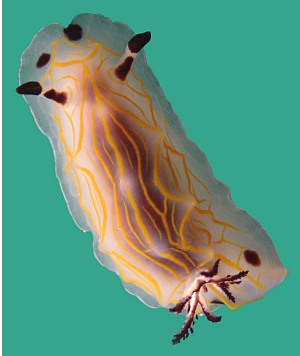
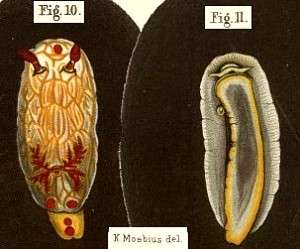
Halgerda formosa
Bergh, 1880
Order: NUDIBRANCHIA
Suborder: DORIDINA
Family: Dorididae
DISTRIBUTION
western Indian Ocean.
PHOTO
UPPER: Pereybere, Mauritius, Indian Ocean. Site: Le Grand Aquarium. Depth: 10m. Size: about 3cm. October 17, 2002 Photo: Marina Poddubetskaia
LOWER: original colour figures of Halgerda formosa published by Bergh (1888 - Pl 77, figs 10, 11).
This species was previously identified with H. punctata, a species described from Ceylon as 'whitish-grey, rather translucent with yellow papillae on mantle' and purple spots on foot and a few also on mantle' (Rudman, 1978 - Zanzibar, Gosliner, 1987 - South Africa).
However Fahey & Gosliner (1999) have concluded that the species illustrated here is H. formosa Bergh, 1880 and that H. punctata is a similarly coloured but distinct species. One external difference they note is that while H. formosa has distinct low ridges lined with yellow or orange, in H. punctata the ridges are indistinct and there are yellow tubercles. Another similarly coloured species is Halgerda toliara which can be distinguished as follows:
•H. formosa (Bergh, 1880) - yellow reticulate pattern - some black spotting around mantle skirt, and small whitish pustules near edge.
•H. toliara Fahey & Gosliner, 1999. - yellow reticulate pattern - no black spots on mantle, small yellow pustules near edge.
References:
• Fahey, S. & Gosliner, T.M. (1999) description of three new species of Halgerda from the western Indian ocean, with a redescription of Halgerda formosa, Bergh, 1880. Proceedings of the California Academy of Sciences, 51(8): 365-383.
• Fahey, S.J. & Gosliner, T.M. (2001) On the genus Halgerda (Nudibranchia: Halgerdidae) from Western Australia with descriptions of four new species. Bollettino Malacologico, 37(5-8): 55-76.
• Rudman, W.B. (1978) The dorid opisthobranch genera Halgerda and Sclerodoris from the Indo-West Pacific. Zoological Journal of the Linnean Society 62: 59-88.
Rudman, W.B., 1999 (November 18) Halgerda formosa Bergh, 1880. [In] Sea Slug Forum. Australian Museum, Sydney. Available from http://www.seaslugforum.net/find/halgform
Related messages
Halgerda from Madagascar
October 22, 2009
From: Sylvain Le Bris
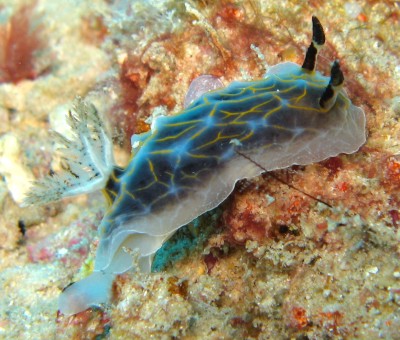
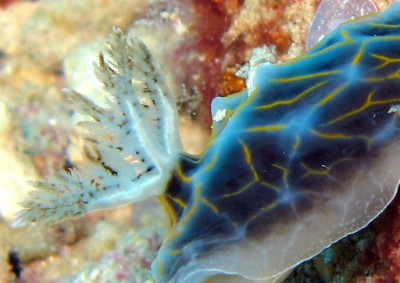
Dear Bill,
I think this Halgerda formosa but I am not sure.
Locality: Nosy Be, 20 m, Madagascar, Indian Ocean, Julu 2009. Photographer: Sylvain LE BRIS.
Sylvain Le Bris
lebris.sylvain@gmail.com
Le Bris, S., 2009 (Oct 22) Halgerda from Madagascar. [Message in] Sea Slug Forum. Australian Museum, Sydney. Available from http://www.seaslugforum.net/find/22682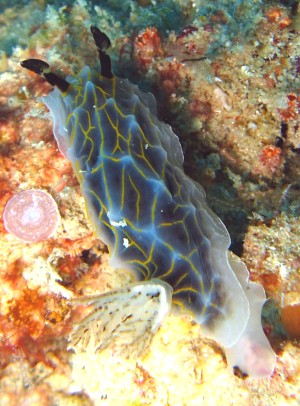
Dear Sylvain,
This belongs to a puzzling group which I am not certain we have completely sorted out at present. It certainly seems to fit what I suspect is part of the colour variation of H. formosa [see message #11824] There seems to be at least one black spot on the posterior part of the foot, and although I can't be sure from the angle of your photos it does seem to have black lines down the dorsal edges of the gills. It definitely has the fine white line along the mantle edge which I suggest in the earlier message is characteristic of this species.
Best wishes,
Bill Rudman
Mating Halgerda formosa from Reunion Island
December 17, 2008
From: Hugues Flodrops
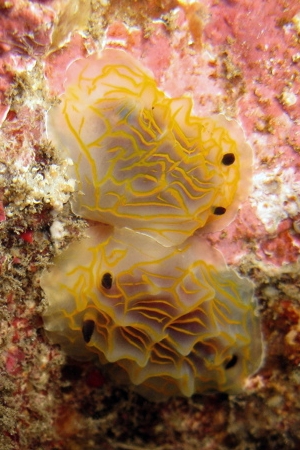
Concerning message #20448:
Dear Bill,
Here is one picture of a pair of Halgerda formosa. I'm sorry for the single picture but there was a lot of current by night inside the grotto. We can see one animal has a black spot on the posterior part of the mantle and the other does not. This picture may be enough to show that H. formosa doesn't always have black spots on the mantle. The rhinophores are partly retratced so we can't see if there is a black line on the rhinophore stalk.
Locality: Etang-Salé "Les Brisants", 1,5 metre, Reunion Island, Indian Ocean, 12 December 2008, By night, strong current. Length: 25-30 mm. Photographer: Hugues Flodrops.
Thanks again for your opinion.
Bests regards.
Hugues.
hugues.flodrops@wanadoo.fr
Flodrops,H., 2008 (Dec 17) Mating Halgerda formosa from Reunion Island. [Message in] Sea Slug Forum. Australian Museum, Sydney. Available from http://www.seaslugforum.net/find/22103Dear Hugues,
Thanks for this photo. It is always good to get a mating pair, especially when they show some differences, as it helps to link different colour patterns to one species. The parallel lines inside the ridges certainly fits Bergh's original painting of H. formosa.
Best wishes,
Bill Rudman
Halgerda formosa ? from South Africa
August 19, 2008
From: Colin Ogden
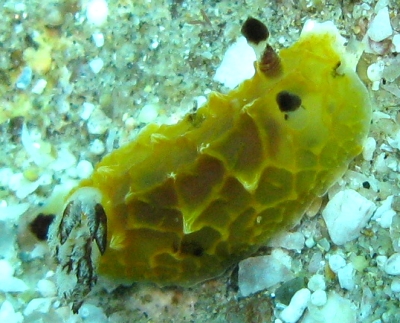
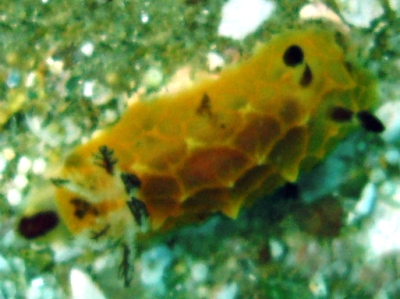
Hi Bill,
Here are some pictures I took in March 2008 of this Halgerda slug from Sodwana Bay. This one I have also only seen once on a reef at 18 meters.
Locality: Sodwana Bay, on reef., 8 m, South Africa, IndianOcean, March 2008, 30 mm. Photographer: Colin Ogden.
Your opinion would be appreciated.
Regards
Colin
scubaco@iafrica.com
Ogden C. M., 2008 (Aug 19) Halgerda formosa ? from South Africa. [Message in] Sea Slug Forum. Australian Museum, Sydney. Available from http://www.seaslugforum.net/find/21817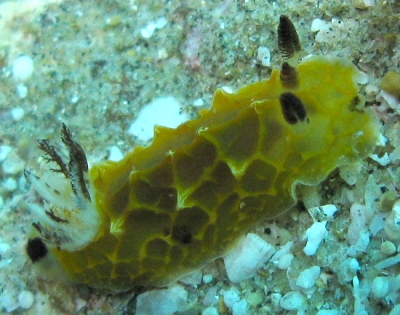
Dear Colin,
It is just as well I don't think my reputation depends on identifying species of Halgerda correctly. If I thought it did I certainly wouldn't attempt to identify specimens from South Africa! Clearly, further research is needed on species from the south western Indian Ocean.
I first thought this could be a form of H. toliara, but one of your photos show one or two black spots on the mantle, and a large spot on the posterior part of the foot, which suggests it is a colour form of H. formosa. I have also tentatively identified some similarly coloured animals as forms of H. wasinensis. There seems to be one group with the upper half of the gills black, and another group with black lines down the edge of the gills. Unfortunately, from your photos, I can't place your animal comfortably into either group. I am identifying your animal as H. formosa, but remember that it is a very tentative identification.
Best wishes,
Bill Rudman
New pattern of Halgerda formosa? from Reunion Island
August 18, 2007
From: Hugues Flodrops
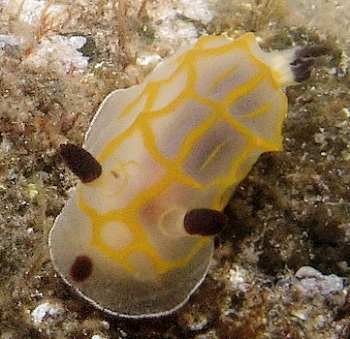
Dear Bill,
I found this specimen of Halgerda few days ago. I think it is H. formosa because there is one black spot on the front of the mantle. But we can observe some differences: there is no black line on the rhinophore stalk and the upper half of each gill seems to be entirely black. So I can't tell if it is Halgerda formosa, or perhaps a variant of Halgerda toliara or a new species.
Locality: Etang-Salé Permanent Pool, 0,8 m, Reunion Island, Indian Ocean, 5 august 2007, Early morning. Length: 18 mm. Photographer: Hugues Flodrops.
Like usually, thanks for your help.
Regards.
Hugues
hugues.flodrops@wanadoo.fr
Flodrops, H., 2007 (Aug 18) New pattern of Halgerda formosa? from Reunion Island. [Message in] Sea Slug Forum. Australian Museum, Sydney. Available from http://www.seaslugforum.net/find/20448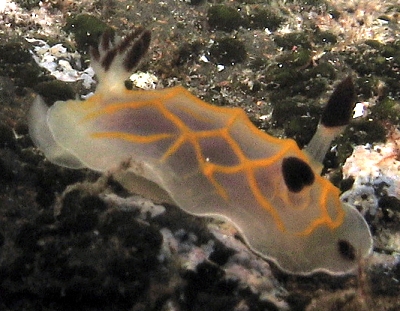
Dear Hugues,
Let us hope that your third suggestion - a new species - is not true. We have enough Halgerda names to sort out at present. I think the colour differences in the gills and rhinophores that you mention are of great importance, but we don't know enough about juvenile colour patterns to know whether the absence of the black marks on the rhinophore stalks and the black colour on the gills is a result of the small size of this animal. On the surface I would suggest H. toliara is the easy answer, but I don't know of any that have black spots on the mantle. In the upper photo it looks like there is the start of a black line of the right rhinophore stalk which would suggest it may be a juvenile still developing its colour pattern.
I think its best to tentatively identify this as H. formosa.
Best wishes,
Bill Rudman
Halgerda formosa -colour variation [1].
January 7, 2004
From: Yves Coze
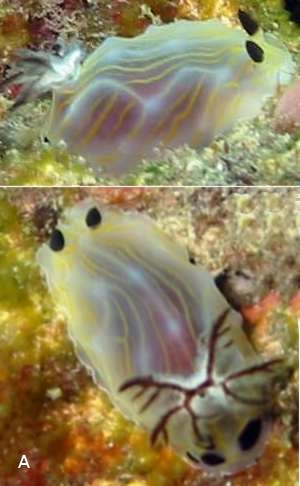
Dear Bill
In response to your comments about my latest message here is a composition of all Halgerda we've spotted here in Reunion Island. There were all spotted either in "Cap La Houssaye" or "Abri Cotier" which are two diving spots separated by approx 4 km. Composition of the spot are the same, Rocky area with various sandy and coral area. I've never spotted any halgerda in other diving places in Reunion, but I guess it's more like bad luck !
Nevertheless, Halgerda were mostly spotted on bare basalt area (60%), we spotted a "group" on a red sponge (20%) , sometimes on sandy area (15%)scarcely on coral reef (5%). According to my dive buddy, they can be spotted on these Red sponges at almost every dive. Maybe the Halgerda feed on these sponges ?
While looking at these pictures I noticed something weird. It noticed that most of the sightings happened between end of May to end of August. We reached a "peak" when we spotted approximately 10 Halgerda during à dive. Would you think they have some kind of "seasonal" behaviour ?
I hope all this will help you.
Best regards
Yves Coze
info@rando-reunion.com
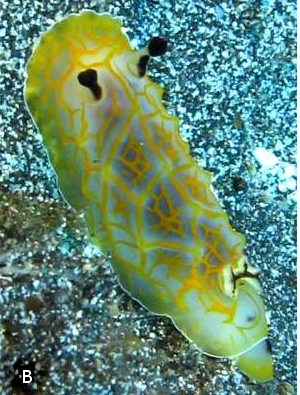
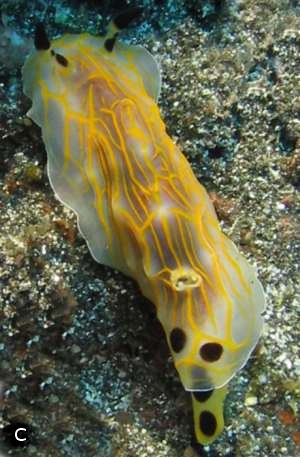
Dear Yves,
Thanks for your great collection of photos. As I wanted to keep the images reasonably large I have separated them into a number of separate messages [see message 2, message 3, message 4]. I am sure they are all one species and so show the variability found in Halgerda formosa. As I have often said, extra photos are never a waste. In this case we now have an excellent idea of the variation to be found in this species. I have discussed the variation in a separate message.
Your observations of this species on a red sponge are also of great interest and almost certainly indicate its food sponge. It is most likely that this species has a seasonal cycle. In tropical waters we tend to think that because there aren't the obvious temperature changes associated with the 'seasons' found in temperate climates, that tropical waters don't have changes during the year. Anyone who has spent much time in tropical environments soon realises that there are indeed seasonal changes in the tropics associated with monsoons, wet seasons etc, and althought there is not much published on the topic, many organisms go through annual cycles just like in temperate waters,
Thanks again for this wonderful collection of photos
Bill Rudman
Halgerda formosa - colour variation [2]
January 7, 2004
From: Yves Coze
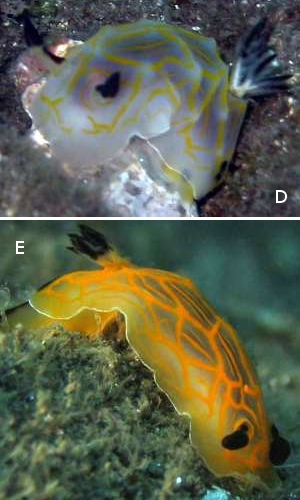
Here are some more of Yves Coze's photos showing colour variation in Halgerda formosa he and his colleagues have spotted in Reunion Island. "They were all spotted either in "Cap La Houssaye" or "Abri Cotier" which are two diving spots separated by approx 4 km. Composition of the spot are the same, Rocky area with various sandy and coral area".
As I wanted to keep the images reasonably large I have separated them into a number of separate messages [see message 1, message 3, message 4]. I am sure they are all one species and so show the variability found in Halgerda formosa. As I have often said, extra photos are never a waste. In this case we now have an excellent idea of the variation to be found in this species. I have discussed the variation in a separate message.
Bill Rudman
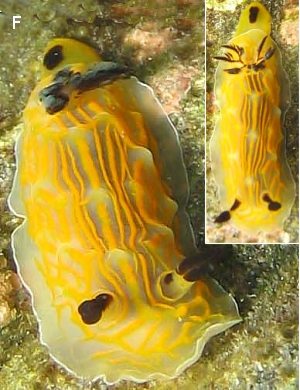
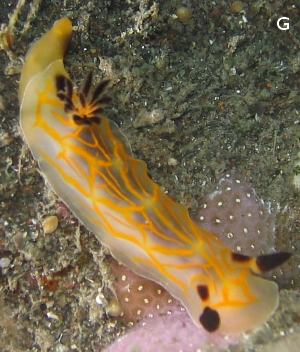
Halgerda formosa - colour variation [3]
January 7, 2004
From: Yves Coze
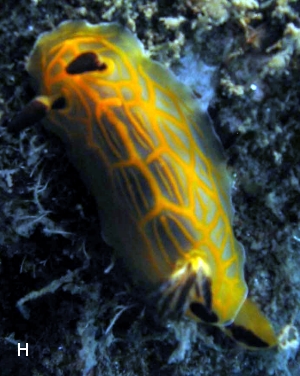
Here are some more of Yves Coze's photos showing colour variation in Halgerda formosa he and his colleagues have spotted in Reunion Island. "They were all spotted either in "Cap La Houssaye" or "Abri Cotier" which are two diving spots separated by approx 4 km. Composition of the spot are the same, Rocky area with various sandy and coral area".
As I wanted to keep the images reasonably large I have separated them into a number of separate messages [see message 1, message 2, message 4]. I am sure they are all one species and so show the variability found in Halgerda formosa. As I have often said, extra photos are never a waste. In this case we now have an excellent idea of the variation to be found in this species. I have discussed the variation in a separate message.
Bill Rudman
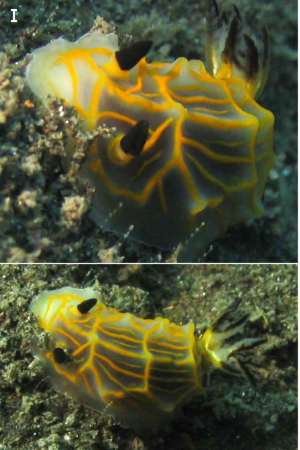
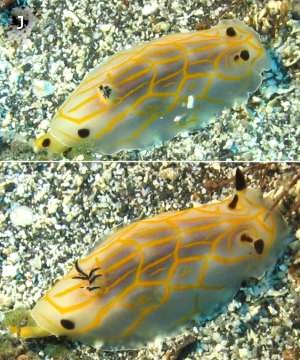
Halgerda formosa - feeding?
January 7, 2004
From: Yves Coze
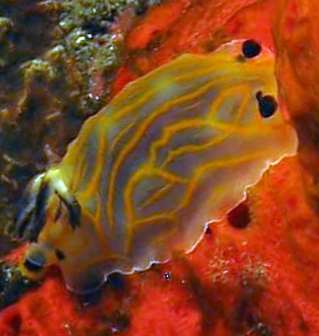
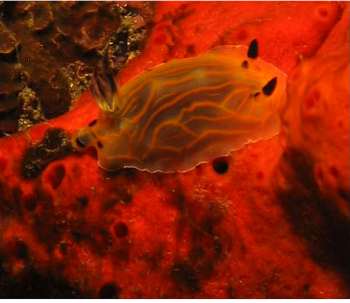
Here are some more of Yves Coze's photos showing colour variation in Halgerda formosa which he and his colleagues have spotted in Reunion Island. This photo shows the red sponge it is often found on.
"They were all spotted either in "Cap La Houssaye" or "Abri Cotier" which are two diving spots separated by approx 4 km. Composition of the spot are the same, Rocky area with various sandy and coral area. Nevertheless, Halgerda were mostly spotted on bare basalt area (60%), we spotted a "group" on a red sponge (20%) , sometimes on sandy area (15%)scarcely on coral reef (5%). According to my dive buddy, they can be spotted on these red sponges at almost every dive. Maybe the Halgerda feed on these sponges ?"
As I wanted to keep the images reasonably large I have separated them into a number of separate messages [see message 1, message 2, message 3]. I have discussed the variation in a separate message.
Bill Rudman
Colour variation in Halgerda formosa
January 7, 2004
From: Bill Rudman
Yves Coze's series of photos of Halgerda formosa from Reunion Island give us a wonderful insight into the variation to be found in this species, which until recently had been known only from a colour painting accompanying its original description in 1880. As I wanted to keep the images reasonably large I have separated them into a number of separate messages [see message 1, message 2, message 3, message 4].
Anyone who has followed the recent messages on the Forum concerning species of Halgerda from the Indian Ocean will have noted that there were still many puzzles to resolve concerning just how many species existed and how characters should be interpreted.
Photo A: Pale colouration. Some yellow parallel lines, no transverse lines. 4 black spots on posterior mantle.
Photo B: Yellow reticulate ridges and secondary reticulate pattern in 'valleys'. Black spot on posterior foot.
Photo C: Yellow reticulate ridges and secondary parallel lines in 'valleys'. Some traces of secondary reticulation. 2-3 black spots on posterior foot and mantle.
Photo D, E: Yellow reticulate ridging and single secondary yellow longitudinal line in each valley. Single black spot on posterior mantle and foot.
Photo F: Parallel yellow lines distinct but few transverse ridges. Black spot on posterior Foot, no spot on mantle.
Photo G: Reticulate yellow ridges but little sign of longitudinal parallel yellow lines. One black spot on posterior foot and mantle.
Photo H: Reticulate yellow ridges and secondary longitudinal yellow lines. One black psot on postreior mantle, broad black band on posterior foot.
Photo I: Reticulate yellow ridges and secondary longitudinal yellow lines. Posterior end not visible for spots.
Photo J: Reticulate yellow ridges, but few secondary parallel lines. One black spot on posterior foot.
Feeding specimen Appears to have yellow longitudinal ridges. No transverse ridging. No black spots.
From these photos and others already on the Forum I think it is worthwhile to summarise the external characteristics of this species:
Mantle translucent white with a thin opaque white line at the mantle edge. There are scattered rounded tubercles, sometimes more pronounced in some animals than in others, and these are joined by a network of ridges which are edged in yellow or orange-yellow. There is a secondary pattern of yellow lines in the 'valleys' arranged in a parallel pattern oriented along the long axis of the body. In some cases there may be only on secondary line in each 'valley', and in other examples, the transverse ridges are absent and longitudinal parallel lines predominate. In one example [Photo B:] the secondary lines form a reticulate pattern. The obvious relationship of that specimen to the rest can be seen in another specimen [Photo C:] in which some of the parallel lines are branched and entangled.
The rhinophores have a black club, and running up the posterior side of the white rhinophore stalk is a band of black. The sparse white gills have a black line running along the inside [upper] edge. The lines on each gill join at the base. This is in contrast to the black line on the outer [lower] edge which stops near the base, so that the outer base of the gill circlet is translucent white.
There can be a few large rounded black spots on the mantle, usually at the posterior end behind the gills. In rare cases there can be one or two at the anterior end in front of the rhinophores. The white foot is edged with a diffuse band of yellow and at the posterior tip there can be one to three rounded black spots on the dorsal midline, or even a broad black band.
Yves'e photos are a valuable addition to our knowledge, and with earlier contributions from Marina Poddubetskaia, have certainly enabled me to clarify just what variability we can expect to find in this species. As I have often said, extra photos are never a waste. By being better able to define this species it means we can better understand other species with similar colour patterns. It certainly suggests that the problematic animals in Certainly animals such as those in message 5, message 6, message 7, message 8, message 9, which have been tentatively placed with H. formosa can no longer stay there. As I am posting in a message from Gavin Bushell, it seems they are a colour variant of Halgerda wasinensis.
Best wishes
Bill Rudman
Halgerda formosa from Reunion Is.
November 26, 2003
From: Yves Coze
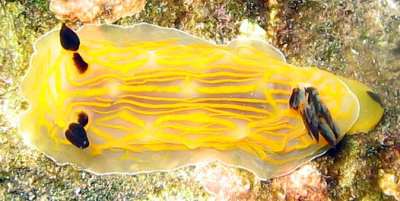
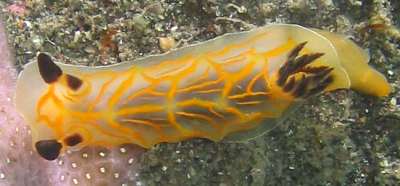
Dear Bill
Here are pictures of what I believe could be Halgerda formosa. These were found in Reunion Island, in La Possession "Abri Côtier".
I spotted two different specimen, both of them on rocky area. One of them was I guess looking for it's way on an coral rock.
In comparison to the specimen sent previously, these were much smaller (no more than 2 cm long) and there lines were more like orange rather than yellow. I guess maybe it's some kind of Juvenile form.
They were in shallow water (5 m deep), but I as I mentioned in a previous message this water sometimes in a mix between fresh and salty water.
As in "Cap La Houssaye", this place is a mix from sponges (brownish and greenish sponges), algae (small algae growing on the rocks) and smal coral reefs.
Hoping this helps.
Best wishes
Yves Coze
info@rando-reunion.com
Coze, Y., 2003 (Nov 26) Halgerda formosa from Reunion Is.. [Message in] Sea Slug Forum. Australian Museum, Sydney. Available from http://www.seaslugforum.net/find/10839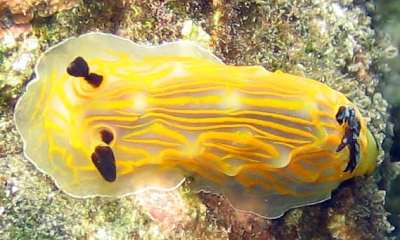
Dear Yves,
We still have some things to learn about these species of Halgerda so it is very helpful to get further photos to help us sort out the degree of variation in each species. I think we can say that some of the important features of this species are the way the yellow lines [and associated ridges]are arranged longitudinally with very few transverse lines. The rhinophore clubs are dark brown or black and there is a dark brown or black line down the posterior side of the rhinophores stalk. The upper edge of the gills are lined with a dark brown or black line. Althought here are no dark spots on the mantle in your animals there appears to be a black mark on the posterior tip of the foot.
I feel that these animals are a form of H. formosa. By chance I am also posting a message today from Marina Poddubetskaia of animals which Shireen Fahey feels is also this species. However as I say in that message I feel that is a different species.
Best wishes
Bill Rudman
Halgerda formosa from Reunion Is.
August 14, 2003
From: Yves Coze
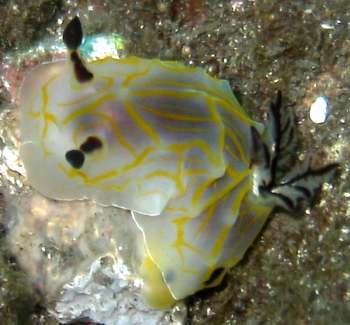
Dear Bill,
Could you please help me identify this slug. Once again it was spotted in Reunion Island, to be more precise in St Paul : Cap La Houssaye.
I guess it looks like Halgerda toliara, but I would be glad if you could confirm it to me. One of these photograph was taken around 12 m deep on a rocky/algae area. It was translucent and moving rather "quickly".
The second one was in shallow waters, at 4 m depth settled in a coral/algae area. A dive buddy of mine says they're spotted rather often around there (not so much as phyllidiids though).
Thank's in advance
Yves
info@rando-reunion.Com
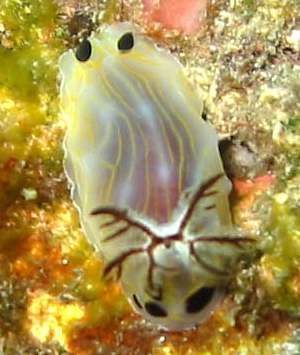
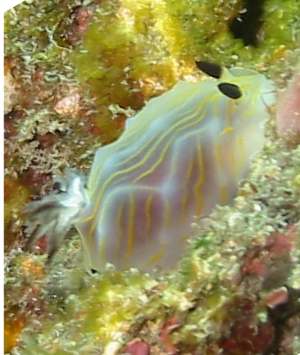
Dear Yves,
This is useful addition to our knowledge of these animals. We are still sorting out just how many species of these yellow lined species there are in the Indian and Pacific Oceans, and the more photos we can get showing colour variation the better.
If you have alook at the other mesages on this page you will see that this matches the original description of Halgerda formosa from Mauritius very well. At present it is known only from the islands of the western Indian Ocean.
Best wishes,
Bill Rudman
Re: Halgerda formosa & H. punctata
January 30, 2003
From: Terry Gosliner
Dear Bill,
Re your comments on Danny Van Belle's Halgerda from Thailand. I certainly agree with you that the specimens of Halgerda formosa that you illustrate from Mauritius are dead-ringers with Bergh's original description. I have some specimens from Madagascar that are somewhat intermediate in their abundance of spots. My intuition tells me that they all represent a single species. What we need to do to verify this is to examine the anatomy of one of the Mauritian specimens to see if it is consistent with the East African material. If the two prove to be different, then the East African animals need a new name, since Halgerda punctata is clearly a distinct species as evidenced by the photo on your site that is identical to Farran's drawing from Sri Lanka, with numerous elevated tubercles, rather than elevated linear ridges. Shireen and I would be happy to have a look at any Mauritian material of H. formosa if specimens are available.
All the best,
Terry
tgosline@calacademy.org
Thanks Terry,
I had forgotten Erwin Koehler's photo of Halgerda punctata. Danny Van Belle's photo and East African specimens, such as in Bernard Picton's photo, certainly match what I previously thought incorrectly (Rudman, 1978) was Farran's H. punctata. If it turns out on anatomical examination to be different from 'true' H. formosa, as typified by the Mauritian photos, it may be a third distinct species in the group. Another mystery is the one in Lindsay Warren's photo from Madagascar.
Best wishes,
Bill Rudman
Note added 31 January 2003: The reply I posted yesterday to Terry's message didn't make sense, because I had ignored Erwin Koehler's photo of H. punctata, so since its only been 24hrs I have replaced my reply. I don't usually change things on the Forum because it will destroy the Forum's archival nature, but in this case a correction would have been more confusing .... Bill
Rudman, W.B., 2003 (Jan 30). Comment on Re: Halgerda formosa & H. punctata by Terry Gosliner. [Message in] Sea Slug Forum. Australian Museum, Sydney. Available from http://www.seaslugforum.net/find/9096Halgerda formosa from Mauritius
November 13, 2002
From: Marina Poddubetskaia
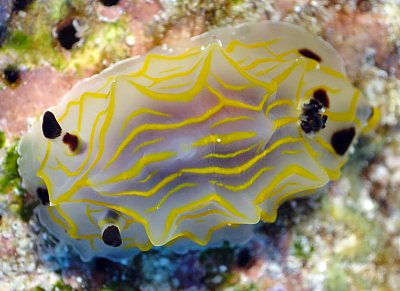
Dear Bill,
Here are some photos of a very nice Halgerda from Mauritius. Is it Halgerda formosa? This animal looks like the one on the Bergh’s picture.
Pereybere, Mauritius, Indian Ocean. Site: Le Grand Aquarium. Depth: 10m. Size: about 3cm. October 17, 2002 Photos: Marina Poddubetskaia - Nembro website
Best wishes,
Marina.
nembro@nembro.info
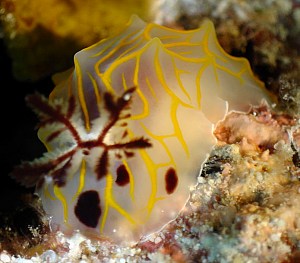

Dear Marina,
Your animals certainly look like Bergh's illustration and certainly fit the description of H. formosa. A very useful addition to our knowledge about these animals
Best wishes,
Bill Rudman
